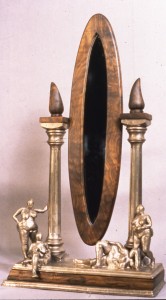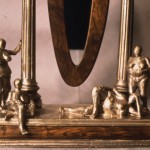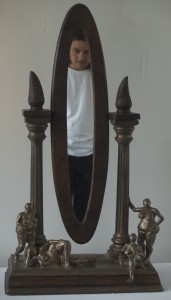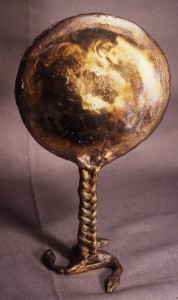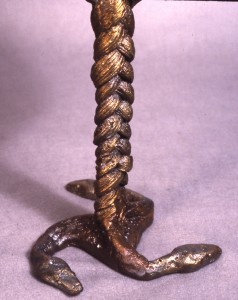So, a special treat today: Context.
I have collected some info and images from Rae’s MFA show, titled above. The show was November 6-23, 1994 at the Gallery of Design, 1300 Linden Drive. At that time it was Family Resources and Consumer Sciences, now the School of Human Ecology.
Her Artist’s Statement:
Women, particularly cultural feminists, have often considered the possibility, questioned the probability, and even a romanticized the concept of a women’s culture. When I explore the concept of women’s culture, as a feminist, a storyteller, and an artist, I am drawn again and again to the concept of common objects. Common objects fascinate me — the careful consideration to function (its domestic roots) mars our perception of its grace and beauty, for, to be special something must be rare.
In a women’s culture, what might be different in the perception and the value of common objects?
I began to envision what common objects would be like from an intact, continuous women’s culture. If such a culture existd through the ages, what would those ages have been called? We have the “Golden Age” for mainstream culture, and the Renaissance, and the “Middle Ages”. Would it be different if there had been a dominant Women’s culture or even a valuation of women? I know they would be different for me. Using as my starting point stories such as the magic mirror of Snow White’s evil stepmother, or myths such as Cerridwen’s Cauldron of regeneration ( how did a cooking pot becomes a source of reincarnation and knowledge )?, I began to construct any exhibition of found objects from this “mythical” women’s culture.
I not only wanted to explore the concept of a women’s culture, I choose to layer it with the shadowed influences of existing culture – its legends, stories and processes and my own life experience and concerns. What resulted is my manifestation of Objects of Power.
This statement was posted in the show and on a brochure which was handed out. What few people have seen is her first draft of the statement:
I am working from 3 premises:
• There is a perceived division between art and craft, functional and non-functional, which does not exist in all cultures and in all times. It does not exist in my reality. I like to push this culturally oriented imaginary line around and see what I can come up with when I explore common objects, traditional and non-traditional materials and layered symbology.
• Certain “Common Objects” fascinate me — they can be graceful and powerful, as well as functional. We usually miss this grace and beauty, because we assume to be special something must be rare. Many objects live with us in the mundane-but they also live with us in the world of dreams, mystery and legend. My work seeks to delve these mysteries and reveal how common objects can become the icons of mysteries we all recognize if we care to look — if we dare to know.
• Objects that are a common part of our culture often have rich associations with legends, histories, fables, folk-tales and folk customs. I explore these associations by researching references to each object in mythic, poetic, and cultural literature. I use interactive and multifaceted meshed layers that reflect this history and hidden meanings found in the research, with concepts from my own life experiences and response to the stories.
This process manifests pieces that are powerful, unique, and sophisticated. These simultaneously simple and sophisticated pieces reflect the mundane perspectives of our society, but reveal a connection to the power of objects through their secrets, stories, mysteries, and innate grace.
Also from the brochure:
ACKNOWLEDGMENTS AND APPRECIATIONS
COMMITTEE MEMBERS:
Truman Lowe – Art Department
Leslee Nelson- Art Dapartment
Elaine Shear – Art Department
Diane Sheehan – ETD Department
And Larry Junkins–
he touched my heart & my art, Blessings.
SPECIAL THANKS TO:
Valerie Weihman – MATC
Tom Loeser – UW
Martha Glowicki – UW
Steve Feren – UW
Fred Fenster – UW
Brian Painter – UW
George Cramer – UW
SPECIAL FRIENDS
Those who helped make this show possible
Helen Klebasadel Jini Kai
Amy Bethel Mary Walker
Barb Westfall Mary Bennett
Ari-Asha Castalia Ann Schaffer
Leslee Nelson Sara Killian
Suzann Hart Val Weihamn
Casey Heinzel Ethan Heinzel
Deb Trent Bev Gordon
Betsy Tuttle and the folks of the Gallery.
And All My Love To,
MATH HEINZEL
Who suffered so gracefully for my art …
The pieces that were included in that show, some renamed:
BROOMS
From the Age of Mystery: SWEEP OF THE MILKY WAY Wildwood, Broom Corn
From the Age of Community: COOPERATION Bronze, Bronze Wire
From Sweeping Changes: INSPIRATIONAL SIMPLICITY Quilted maple, Broom Corn
CAULDRONS
From the Age of Water: CONTINUITY Bronze
From the Age of Fire: TRANSFORMATION Bronze
From the Age of Earth: REGENERATION Bronze
CHAIR
From the Age of Consideration: FAT GIRLS LIKE TO ROCK TOO Ash and Pecan
CUPBOARDS
From the Age of Confusion: ANCIENT MOTHER/MODERN LIES Walnut, fabric, mirror, bronze, clay, glass
From the Age of Consciousness: CAGED HEAT maple, copper, cotton, silk, satin
From the Age of Control: WITH RESPECT TO THE WHORE OF BABYLON copper, lace, walnut, silk
MIRRORS
From the Age of Knowledge: CLASSICAL PROPORTIONS/NARROW PERSPECTIVES Bronze, Wood, Mirror
From the Age of Acceptance: MIRROR OF DEATH/MIRROR OF LIFE Bronze
——————–
I have not found any photos from that exhibition, though I will continue to look. We do have photos of all the pieces, some in previous posts here, others yet to come. For now, for your gazing pleasure, the Rocking Chair that she made to fit a large woman, and which now belongs to her little sister Dawn. Made of Ash and Hickory. Fat Girls Like to Rock, Too:
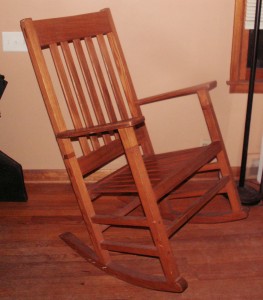
Proportioned for the Goddess in each of us.
